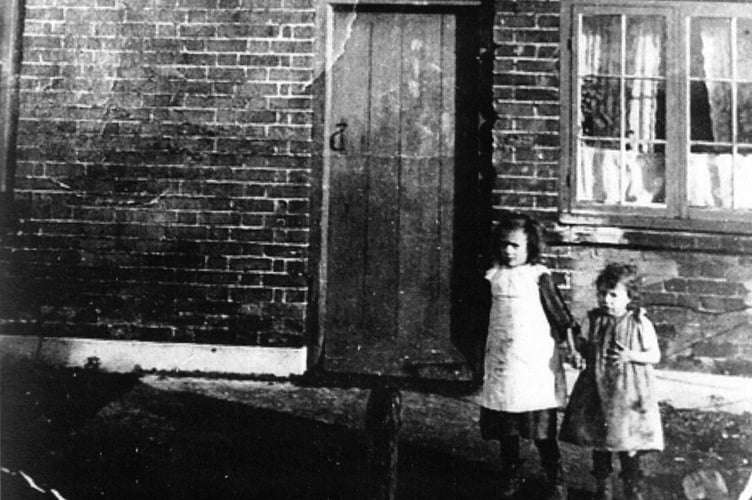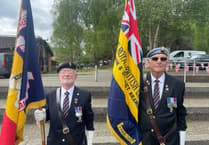“YOU may like this story of Badshot Lea’s forgotten hero for Peeps into the Past,” writes Maurice Hewins. “He was Farnham’s most decorated Great War soldier, being awarded the DCM plus the Military Medal and bar.
“William Henry Crumplin was born in Farnham, in 1897, to Henry Crumplin and his wife Annie. In the 1901 census the family were living in the town at 5 Burningham’s Buildings, Bridge Square (can any reader identify where Burningham’s Buildings were located?). Henry was working as a bricklayer’s labourer. William was aged four and he had a brother, Arthur George, aged three, while his sister, Louisa Ann was just one.
“This photo (above) was taken at a family wedding at Badshot Lea in 1949. William and his mother are standing on the church path in front of headteacher, Rankine’s, house (photo from the Crumplin family).
“A few years later the Crumplins had moved to Badshot Lea into old buildings that stood on the site of Rankine Close, where they were recorded in the 1911 census.
“By then Annie had given birth to three more daughters, Mable, eight, Dorothy, six, and Ellen, two. Conditions must have been very crowded as the census reported the family of eight were living in just three rooms.
“By 1911 William had left school at 14 and started work as a nursery labourer.

“In view of the poor living conditions, it is not surprising William was caught up with the other village lads in the rush to join Kitchener’s Army. He enlisted at Stoughton Barracks, Guildford, the depot of the Queen’s Royal (West Surrey) Regiment, and given the number G/1685.
“William was drafted into the 7th (Service) Battalion of the Queen’s, and five other Badshot Lea lads joined him in the battalion. They were G/1171 William Church, G/1698 Walter White, G/1719 Thomas Sawkins, G/5970 George Hansford and G/1616 Walter Roe.
“The 7th Queen’s landed in France on July 27, 1915, as a unit of General Ivor Maxse’s 18th (Eastern) Division. In its first major action, the 18th Eastern was one of those which secured all their objectives on July 1 when they took Montauban. They went on to be one of the best Kitchener divisions on the Western Front, fighting at Arras, Passchendaele and the battles of the last hundred days.
“What extra something made William Crumplin a special hero we can never know, but when he returned home at the end of the war, the Farnham Herald reported that: “Sergeant William Crumplin of Badshot Lea, and an old boy of the school, went all through the war with the 7th Queen’s. He was promoted from corporal to sergeant for bravery near Albert, and won the DCM. The bar to his MM was won just before the armistice.”
“The citation for his DCM ran: “For conspicuous gallantry and devotion to duty in the attack on Tara Hill on August 23, 1918, when with two other men he dashed out in front of our advancing line and quietened a machine gun, killing two of the crew and driving the rest off.
“Later he went out alone and established contact with the battalion on the left. During the whole day’s fighting he set a fine example to all ranks.”
“By August 1919 William was back in Badshot Lea with his family at Knights Cottage, Crown Lane, and in 1939 he was living with his wife Minnie May at 4 Arthur Cottages, Frimley Green, Ash Vale. He was at the same address when he was buried in the churchyard of St Peter’s Church, Ash, on October 24, 1961, aged 65.”
- If you have any Peeps into the Past you’d like us to share, please email [email protected]




Comments
This article has no comments yet. Be the first to leave a comment.